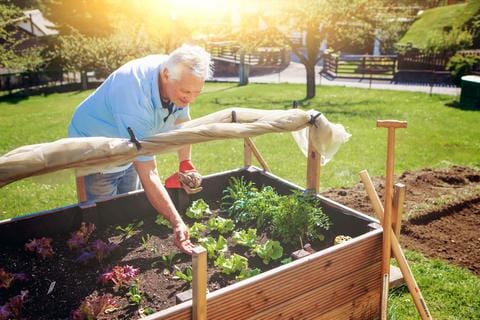Red leaf, radicchio, romaine, and more. With such an abundance of delicious and nutritious lettuce varieties available, it can be challenging to choose just one to grow in your garden. The good news is that cultivating lettuce is almost as simple as sprinkling seeds (one of the reasons they are simply the perfect succession plant) so you can try and taste a new type of lettuce almost any time you like!
From simple spinach to elegant endives, Pinetree Garden Seeds sells a wide variety of organic, heirloom, non-GMO lettuce seeds and we are here to share with you all we know about how to grow lettuce at home.
How to Plant Lettuce Seeds
Before you begin planting lettuce seeds, watch the weather. Lettuce grows best and is less likely to bolt (or shift from making leaves to making flowers) in the cooler months of late spring and early autumn. Most lettuce varieties prefer soil temperatures between 50 and 70 degrees and are not likely to sprout in the sweltering heat of summer in most growing zones.
If your sunny beds are baking your buttercrunch, schedule some shade with taller companion crops. Arrange sunflowers, pole beans, and tomatoes to supply shade during the hottest part of the day (but not to take the sun away entirely) and your bibb will no longer bolt too soon. Layers of straw and mulch also keep soil cool while helping to maintain moisture.
Growing Lettuce from Seedlings
Lettuce may be a cool-weather crop, but that doesn't mean it likes cold soil. Here in Maine, we give our seeds a head start by growing them indoors where we can better control their climate. When it is time to transplant—or when it is clear that your seedlings are taking over the pot you planted them in—take care to disturb the roots as little as possible on the way to their new home.
And remember how lettuce doesn’t like cold soil? It also doesn’t thrive in poor soil or in crowded conditions. Space your plantings appropriately, no matter how spindly they seem at first. Make sure your soil is moist, rich, and crumbly to the touch. The taste of lettuce will tell you if you got it right—lettuce leaves tend to toughen and taste bitter if the growing conditions aren’t at their best.
How Long Does it Take Lettuce to Grow?

It all depends on what you would like to harvest! Based on the temperature of your soil, lettuce germination can take place in 7-10 days and most lettuces mature in 45-55 days. A few varieties (like romaine) take a bit longer to reach their full size but that doesn’t mean you have to wait!
Remember the younger the plant, the more tender the leaves. So if you are craving crunch all year, grow leaf lettuce in small, staggered amounts as often as you can. Each harvest will make space for another succession of plants—and make the most of your growing season.
Small but Mighty Microgreens
Harvested less than a month after germination when they are approximately two inches tall, microgreens are quick to grow and packed with nutrients. Think of them as adolescent lettuce. Salad greens, leafy vegetables like cabbage or broccoli, and even herbs can all be cultivated in containers and cut when they are still small. Start with organic lettuce seeds and you’ll be growing microgreens that are good for you and your garden.
Younger than microgreens (and eaten from root to shoot) lettuce sprouts grow quickly in the smallest of spaces without much light and are a favorite option for windowsills. Once your tiny greens have been harvested you can start a new crop in the same soil. Growing sprouts and microgreens also makes it easy to experiment. Beet leaves too bitter? Try eating them at a different developmental stage to find the flavor you like best.
What are your favorite varieties of lettuce? How do you plant, protect, and pluck your lettuce greens? Let us know in the comments!


Lettuce is very easy to grow. Honestly, I was also growing it on the balcony when I was living in my previous flat (I didn’t have garden that time) and everything was doing very good. I remember only that I needed a bigger container to grow few lettuces at once because they need some space. This year I have tried a package of few different varieties’ seeds from https://gardenseedsmarket.com/lettuce-variety-mix-coated-seeds.html . I have bought it few months ago and planted as soon as the weather allowed it.
Your lettuce seeds are the best! I plant both spring and fall lettuce crop in Eastern PA. We had a mild winter last year and I covered a half dozen lettuce plants with an old glass window that were still growing after frost in my raised bed. To my amazement, they survived the entire winter and began growing again in the spring.
Many years ago in central FL my young daughter and I would get our shovels and turn a place by hand and plant Pinetree’s lettuce mix. Some winters it was all the garden we got planted but we were never disappointed. The lettuce was easy to grow and the array of colors against the bleak winter landscape was beautiful.
We added cow manure from the pasture and we had wonderful wintertime salads and visitors marveled over its beauty.
I’ve just ordered the lettuce mix again and that’s exciting but even more exciting is that my daughter, now 31 and with two young children of her own are gardening and loving it. Her and I often remember our fun winter gardens of long ago but the memories are still in the making….
I appreciate the tips, they explain a lot. Thank you.
Favorite lettuce: Tango and Rouge De Hivar. I plant in containers or in the soil. I give them a sunny location for spring. The sun climbs in the sky as summer progresses and the peach tree shades the lettuce bed till late afternoon. Containers I just move around and they end up in the greenhouse producing until December/January with ambient temps of 25-30 degrees. Some of those containers will winter over inside the house. The crop has been picked one leaf at a time until finally there are just enough leaves left to support the blossoms and then save the seeds. A new crop goes in and the sun lowers in the sky and the lettuce has full sun again from late August to May. These two varieties of lettuce actually will self seed for me. The late crop will stay green during the winter with a thin – thick blanket of chopped leaves. If the snow melts and it is a warmer January-March, I can harvest some leaves of the Rouge De Hivar. The self seeded plants are first to really take off in the early spring. Here in Michigan with 20 +/ winter temps I often can eat lettuce all 12 months.